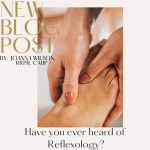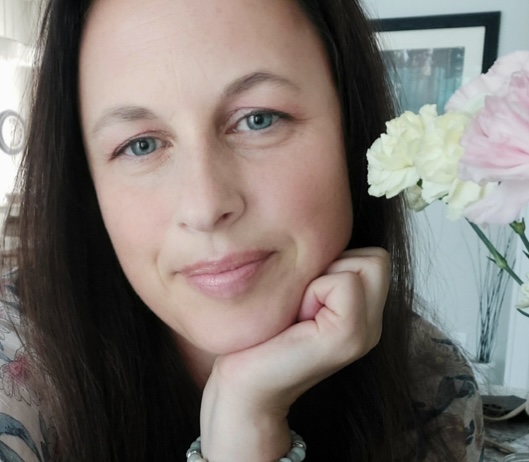Blog Written By: Joanna Wilson, RRPr, CAHP

Reflexology is a natural healing modality based on principles that there are reflexes in the feet and hands that correspond to all parts of the body. So, if I were to put both your feet together side by side it would be the “road map” to your body – from the top of your head to the tips of your toes and everything in between! Specific and even pressure applied to these reflexes helps stimulate the body’s own healing processes that can lead to better quality of sleep, healthy digestion and the ease of aches and pains.
Reflexology is deeply relaxing. It can ease stress and tension in the body. I like to refer to reflexology as the “internal massage”. As the body relaxes, the nervous system moves from the sympathetic state (fight or flight) to the parasympathetic (rest, digest, and repair). The state of rest, digest and repair is an integral part of the body’s natural healing abilities. It can improve lymphatic function (removing waste product) and cardiovascular circulation (keeping blood flowing freelycarrying oxygen and nutrients).
When best describing reflexology, it is a holistic approach to wellbeing. Although there are specific organs and glands that can be given extra attention, we truly approach the body as a whole. As a certified reflexologist, I keep in mind how all the systems of the body work together, and what is needed to maintain homeostasis, which is a state of balance within the body to ensure it functions at its best.
Negative stress is a major factor in an unbalanced body.Negative stress you say? Isn’t all stress bad? Actually, no! An example of positive stress, or “Eustress”, is a life challenge that, when overcome can lead to learning and growing. If over time this life challenge becomes too heavy or too difficult, the body leans into “Distress”. What does that look like? The body in distress (or negative stress) raises cortisol levels that will increase blood pressure and heart rate. This in turn can lead to shortness of breath, headaches, muscle tension, irritability, and anxiety. If not managed, these symptoms over time can put a strain on the body’s systems that affect sleep and digestion. This is the stress we all know, and this is where reflexology can help!
Keep in mind, you don’t need to have any specific reason to have a reflexology session. It is a wonderful way to find relaxation during a tough week or it can be a part of your preventative health care.
Everyone can benefit from reflexology! For babies, young children and the elderly, a gentler pressure is applied, and the length of the treatment is shorter. Reflexology is also wonderful if you are pregnant. It can help ease back pain, reduce fluid retention, and help regulate mood. However, it is recommended that you wait until after your first trimester (12 weeks) before having a treatment.
There are some instances however, where you would want to wait to have a reflexology session. If you have a foot injury orinfection, deep venous thrombosis, or phlebitis in your legs, it is highly recommended that you either wait to have a session or try hand reflexology. A session of hand reflexology is lovely with steam towels and gentle pressure massage for those tired hands that work hard all day!
If you’re curious about what a reflexology session looks like, it begins with the first visit where a health assessment form is completed, and any health issues are discussed. We then talk about your health goals and what you’d like to achieve. A session can range from a half hour to a full hour with steam towels to start. Let the relaxation begin!
During a session there can be certain reflexes that are tender or sensitive. This tenderness is not uncommon and can diminish quickly. A gentler pressure is used on these areas as well.
By the end of your session, you should feel deeply relaxed, and your feet feeling “lighter”. As the body balances and functions normalize, there is the potential to feel a bit tired. A bit of rest and lots of water is always recommended to help. Please note that as a certified reflexologist, I do not diagnose, treat, or prescribe medications for specific illnesses.
Wondering how long reflexology has been around? It can be traced back to ancient Egyptian wall paintings, found in the pyramid of Ankmahor (known as the “physician’s tomb”) depicting patients having treatments done on hands and feet.Amazing!
So, are you ready to try something amazing?
About Joanna:

Joanna’s personal healing journey began in 2009 when she was introduced to reflexology. That was the first time she dipped hertoe into the realm of holistic alternative therapies, and she had no idea how her life would change! From that day on she surrounded herself with the vibrant energy of reiki and reflexology. She went to school to earn her Registered Reflexology Practitioner (RRPr) designation and became aregistered member of the Reflexology Registration Council (RRCO). This organization is a well-respected professional voice for practicing reflexologists in Ontario. Joanna has also received her first and second level of Usui reiki.
Her goal today is to support your personal healing journey through non-invasive holistic therapies such as reflexology, reiki, and aromatherapy massage. A gentle, yet effective approach to health and wellbeing.
Joanna can be found on Instagram @breathandbalance111


